While rummaging around the attic, I came across three old school desks that my siblings and I used back in the day. My dad picked the desks up from somewhere, probably very cheaply (if not free) and we used them hard for a number of years. After we left the roost, the desks were stored in the attic and there they sat undisturbed – except for the occasional mouse visit – for over 30 years.
The desks were well worn but still functional. Although there was no manufacturer’s label or other identifying features on the desks, I think this design dates back to the 1930’s, based on the little bit of Internet research that I performed. It features a lift-up lid with a book storage well underneath, an inkwell, pencil storage slots, and a swivel chair. The frame is made from rolled steel tubing. Both the desk top and chair are adjustable up and down. The top adjusts from roughly 24″ to 27″ high and is 20.5″ wide. The overall length of the desk is about 30″.
Vintage school desks such as these are fairly common and not worth a whole lot. However, I thought it would be an interesting challenge to restore one of the desks to original condition, but with a brighter, more inspiring color.
The paint on the desk was blistered and gnarly. In some areas, notably the upper surfaces of the legs and main cross bar, the paint was warn off entirely and replaced with rust.The original color of the desk was olive green. At some point – probably more than once – it was repainted dark green. Or, is that “public school green”?
The wooden parts of the desk were all made from hard maple, including the desk top. As one might expect from a desk this old, the surface was in less than pristine condition – lots of crayon, pen and pencil marks, scratches, stains, and miscellaneous dings. Although its hard to see in this photo, the upper left corner of the lid was cracked. Otherwise, it was in reasonably good condition.
The book storage well was in pretty rough shape. It was full of paper scraps that mice were apparently using as bedding. The varnish on the underside of the lid had darkened considerably over the years. Not to mention the accumulation of dirt, paint, pen marks, dried gum, dried snot, and who knows what else…Two metal strips were inserted into dovetailed slots running crosswise along the underside of the lid. I presume they helped keep the lid from splitting apart what with the lid being slammed down, walked on, and the other abuses heaped on by school kids.
The book storage well was held together with a number of screws and a couple rivets. Note all the rust along the edges. The well bottom was a heavy piece of 3/4″ thick maple.My little brother stuck the Wynn’s sticker on the desk a long time ago. (Wynn’s is a company that makes auto products). The sticker did add a little character to the desk although I’m not sure why it was positioned upside down.
Once all the wooden parts were removed, the old varnish and paint were removed with a chemical paint stripper and lots of elbow grease.There were splits in both the chair and the desk top that needed fixing. This mostly involved squeezing glue into the split and clamping until dry. However, several of the splits had to be opened up a bit more via creative clamp and block work to find purchase for the glue.
With the old finish removed and the surface sanded smooth, the wooden parts almost looked as good as new. The ink well piece and the chair bottom contained some eye-popping birds-eye maple.I took a light planer pass over the desk top which cleaned it up nicely and removed some of the deeper stains and dings. I considered keeping the top in its beat-up, er… I mean “authentic” condition, but once the decision was made to do a full restore, it was full-steam ahead. Besides, it wasn’t like I was destroying a priceless antique.
The metal parts were sand blasted to bare metal, sanded smooth, and then coated with grey primer. I decided to “outsource” the sand blasting because my sand blasting equipment wasn’t adequate for the job. It ended up costing about $100, about twice what I was hoping to spend (the shop charged $44/hour plus materials) but they did a good job and completed the work in a couple days.
Once the primer dried, I applied several coats of Rust-Oleum Brilliant Blue. Note the olive Army green color of the chair swivel mechanism. I believe this was the original color of the entire desk. I decided to leave this part as the original color since it’s not visible and because it might make for an interesting discovery by some future desk restorer (right).
The underside of the restored desk. I kept the original screws for the underside of the book well and the chair swivel mechanism. These screws were reconditioned by removing any rust with a wire wheel brush followed by a coating of a rust-resistant primer.The original bolts for the chair and desk top adjustment clamps were stripped so I replaced them. After sliding the desk top up and down a few times, the outer layer of paint on the adjustment post was stripped off exposing the grey primer underneath. If I did it again, I would only apply the primer (perhaps a darker color) and skip the top coat.
The top of the desk lid came out rather well I think. If you look in the upper left corner, you can just discern the split lines of an area that was in such bad shape (pre-restoration) that it was in danger of breaking loose. With a little glue and epoxy, it’s as good as new.The lid had some warp to it that I was only partially successful in straightening out. But I don’t think a child will notice or care.
Perhaps it was overkill, but I took some pains to make the inside of the book storage well look presentable. The metal support strips in the underside of the lid were removed, cleaned, and repainted a dark blue. Same for the pencil well. Adhesive vinyl bumpers were placed on the two outer corners of the lid.The metal sides of the book well were originally attached to the slanted back piece with steel rivets. I replaced the rivets with short screws in which the head was ground flat.
This side view shows the repaired split on the upper left corner of the lid as well as the residual warp. I think the brilliant blue offers an intriguing contrast to the amber-colored maple.To finish the wooden parts, I sprayed on a couple coats of 2-lb cut shellac followed by a top coat of semi-gloss Minwax polyurethane. I figured this would provide a good combination of finish thickness coupled with the poly’s excellent resistance to wear, water, alcohol, and other solvents.
It was a satisfying experience restoring this battered old school desk to near-new condition. The job took 18 hours and cost about $120, mostly for the sand blasting. I’m not sure what I’ll do with the restored desk but I hope it ultimately ends up in a good home and gets put back into service. Maybe if I restore one of the other desks in the attic and paint it pink, I can sell the pair to a family with a boy and a girl? Something to think about…


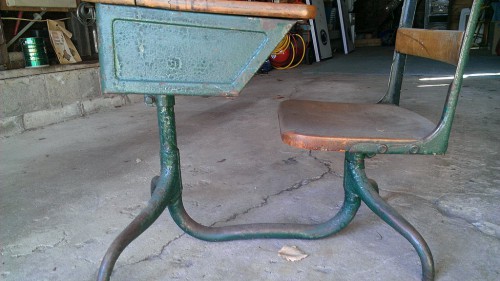
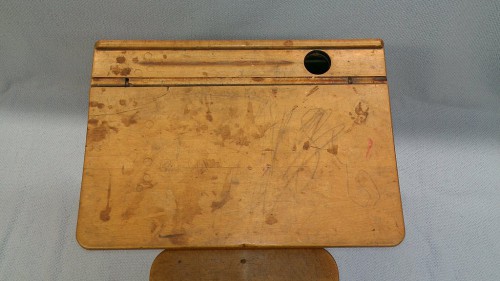
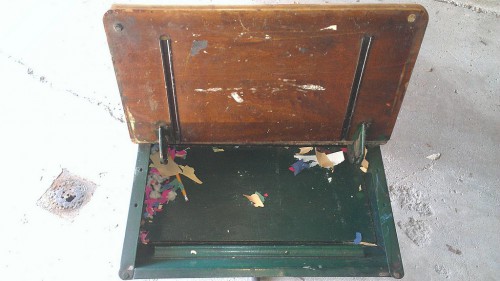
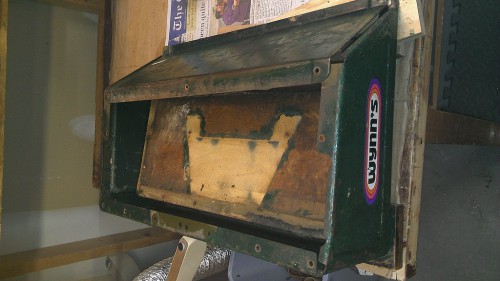
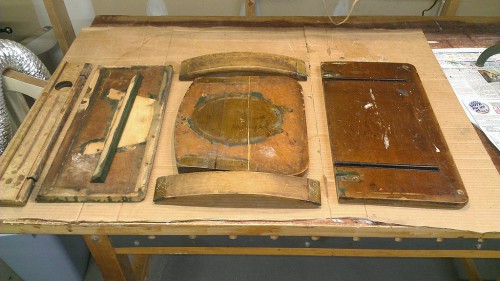
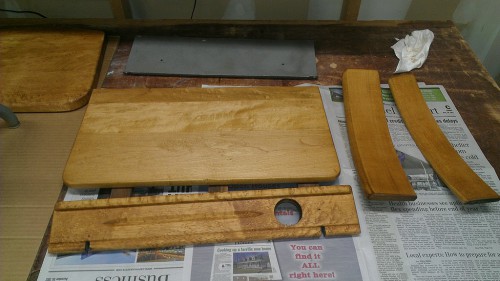
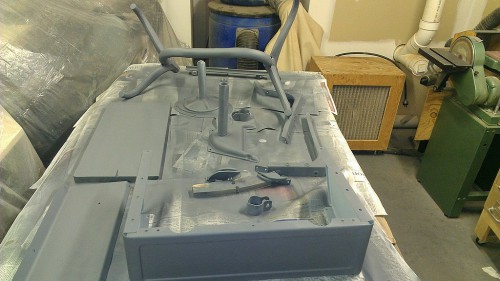
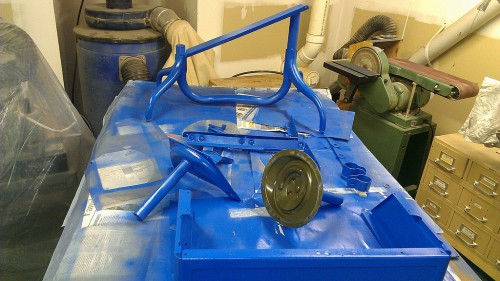
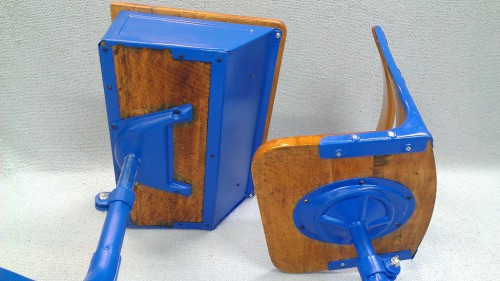
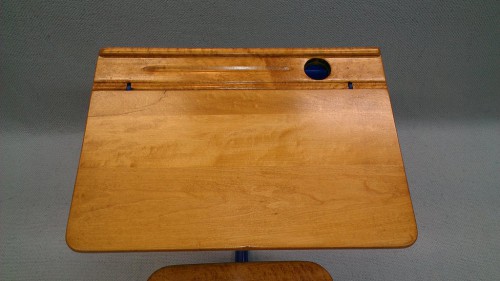
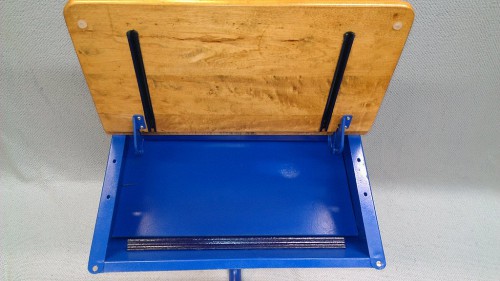
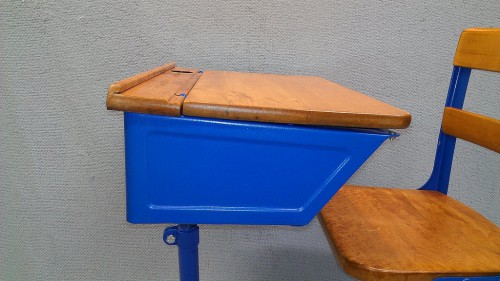
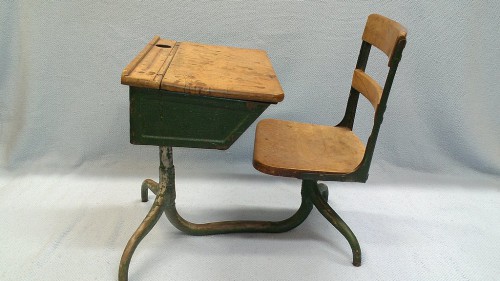
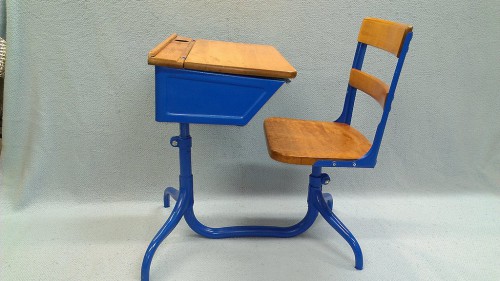
Very nice, especially considering its condition before restoration.
I restored one like this some years back, rusted, wood cracked and warped and generally in poor condition. The restoration ended well but, not without some painful bumps in the road. My final coat of polyurethane was dry, but a little shop dust had settled on it so I grabbed a clean shop towel to wipe it. To my horror, my new finish now had dog hair stuck to it everywhere. My wife had washed the dog blanket and my shop towels together. The fault rests with me for using a shop towel, regardless what was on it. By the time I die, I may know everything there is to know, about what Not to do.
I,m working on exactly the same project, however the hinges are broken and I,m trying to find a source for them, any Ideas? sincerely Wayne Bolduc/n.h.
Check out schoolfix.com. They seem to have a decent selection of hinges:
http://www.schoolfix.com/classroom-furniture/replacement-chair-desk-parts.html
How do you take the clamp off that raises and lowers the desk? Can’t figure it out! Thanks.